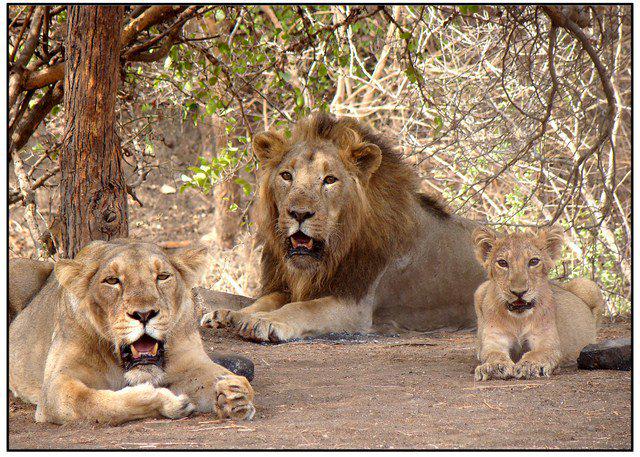Gir Forest National Park and Wildlife Sanctuary, also known as Sasan-Gir, is a wildlife sanctuary and protected forest area in Gujarat, India. It is considered one of the most important protected natural areas in Asia due to the rare animals living here, particularly the pure Asiatic Lions (Panthera leo leo).
The scientific classification of the various types of lion has changed: Asiatic lions are now viewed as an isolated population of a subspecies that includes lions in Central and West Africa, plus the regionally extinct North African lion. Lions of East and Southern Africa are classified into another subspecies.
The park has a total area of 1412 km², from which 258 km² are in the fully protected national park and the remaining 1153 km² make up the sanctuary.

The Gir forest area and the Asiatic lions were first "protected" by the Nawab of the princely state of Junagadh as early as the start of the 20th century, which saved the lion population from fully disappearing as a result of trophy hunting. In 1965 the national park was established.
In 2005 there were only 52 Asiatic lions in the wild, leaving the population on the brink of extinction, but conservation efforts have resulted in a major population increase, with over 500 individuals now living.
Between April to June it can be very hot due to tropical heat. From November to early February, the weather is pretty cool, and this is the most pleasant season to visit. However during end of December it may feel chilly, make sure to carry your jackets for safety.
From June 16 to October 15, the park is closed due to the summer monsoon.
See the Gir National Park Website to reserve an entry permit.
- Among the many species living here, the Asiatic lion is surely the most treasured of all, as the Gir Forest National Park is the only place in the world where these rare lions have survived. A breeding programme was set up and so far succeeded in bringing forward some 180 lions. In 2015 the population here was 523.
- Other fauna is diverse and plentiful and includes at least 38 mammals and some 300 species of birds. Some 37 different species of reptiles have been documented too. Among the most spectacular possible sightings are Indian Leopards, jungle cats, striped hyenas, sloth bears and Indian cobras. There are golden jackals, Indian mongoose, Ratels and Indian Palm Civets as well as chital deer, nilgai, four-horned Antelopes, wild boars and many other animals.
- Flora in the area is also of high value, with over 500 plant species documented.
Among the many species living here, the Asiatic lion is surely the most treasured of all, as the Gir Forest National Park is the only place in the world where these rare lions have survived. A breeding programme was set up and so far succeeded in bringing forward some 180 lions. In 2015 the population here was 523.
Other fauna is diverse and plentiful and includes at least 38 mammals and some 300 species of birds. Some 37 different species of reptiles have been documented too. Among the most spectacular possible sightings are Indian Leopards, jungle cats, striped hyenas, sloth bears and Indian cobras. There are golden jackals, Indian mongoose, Ratels and Indian Palm Civets as well as chital deer, nilgai, four-horned Antelopes, wild boars and many other animals.
Dry & fried snacks like potato chips are easily available. There are small food stalls with average quality of food are present. Prices are nominal. Make sure to drink bottled mineral water for safety.
